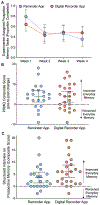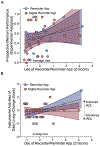Using smartphone technology to improve prospective memory functioning: A randomized controlled trial
- PMID: 34786698
- PMCID: PMC8821124
- DOI: 10.1111/jgs.17551
Using smartphone technology to improve prospective memory functioning: A randomized controlled trial
Abstract
Background: A decline in the ability to perform daily intentions-known as prospective memory-is a key driver of everyday functional impairment in dementia. In the absence of effective pharmacological treatments, there is a need for developing, testing, and optimizing behavioral interventions that can bolster daily prospective memory functioning. We investigated the feasibility and efficacy of smartphone-based strategies for prospective memory in persons with cognitive impairment.
Methods: Fifty-two older adults (74.79 ± 7.20 years) meeting diagnostic criteria for mild cognitive impairment or mild dementia were enrolled in a 4-week randomized controlled trial. Participants were trained to use a digital voice recorder app or a reminder app to off-load prospective memory intentions. Prospective memory was assessed using experimenter-assigned tasks (e.g., call the laboratory on assigned days), standardized questionnaires, and structured interviews. Secondary dependent measures included days of phone and app usage, acceptability ratings, quality of life, and independent activities of daily living.
Results: Participant ratings indicated that the intervention was acceptable and feasible. Furthermore, after the four-week intervention, participants reported improvements in daily prospective memory functioning on standardized questionnaires (p < 0.001, ηp2 = 0.285) and the structured interview (p < 0.001, d = 1.75). Participants performed relatively well on experimenter-assigned prospective memory tasks (51.7% ± 27.8%), with performance levels favoring the reminder app in Week 1, but reversing to favor the digital recorder app in Week 4 (p = 0.010, ηp2 = 0.079). Correlational analyses indicated that greater usage of the digital recorder or reminder app was associated with better prospective memory performance and greater improvements in instrumental activities of daily living (completed by care partners), even when controlling for condition, age, baseline cognitive functioning, and baseline smartphone experience.
Conclusions: Older adults with cognitive disorders can learn smartphone-based memory strategies and doing so benefits prospective memory functioning and independence.
Keywords: Alzheimer's disease and related dementias; assistive technology; electronic memory aid; offloading; technology and dementia.
© 2021 The American Geriatrics Society.
Conflict of interest statement
Figures




Comment in
-
Reply to: Comment on: Using smartphone technology to improve prospective memory functioning.J Am Geriatr Soc. 2022 May;70(5):1582-1584. doi: 10.1111/jgs.17691. Epub 2022 Feb 12. J Am Geriatr Soc. 2022. PMID: 35150440 Free PMC article. No abstract available.
-
Comment on: Using smartphone technology to improve prospective memory functioning.J Am Geriatr Soc. 2022 May;70(5):1581-1582. doi: 10.1111/jgs.17689. Epub 2022 Feb 12. J Am Geriatr Soc. 2022. PMID: 35150444 No abstract available.
References
-
- Henry JD. Prospective memory impairment in neurological disorders: implications and management. Nat Rev Neurol. 2021;17(5):297–307. - PubMed
-
- Servick K Alzheimer’s drug approved despite murky results. Science. 2021;372(6547):1141. - PubMed
-
- Jones WE, Benge JF, Scullin MK. Preserving prospective memory in daily life: A systematic review and meta-analysis of mnemonic strategy, cognitive training, external memory aid, and combination interventions. Neuropsychology. 2021;35(1):123–140. - PubMed
Publication types
MeSH terms
Grants and funding
LinkOut - more resources
Full Text Sources
Medical
Miscellaneous

